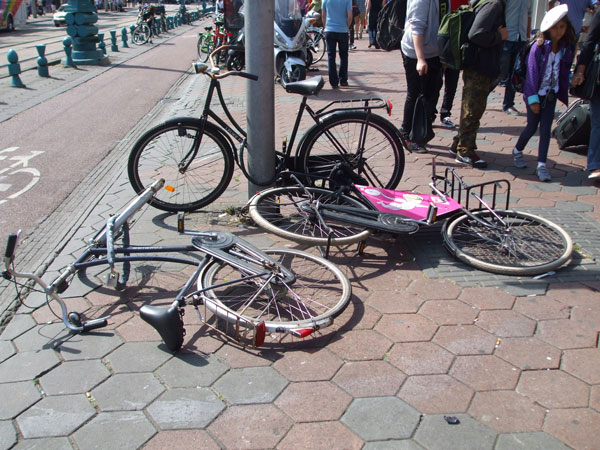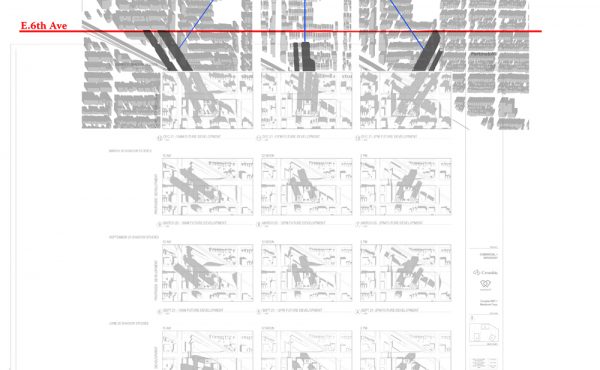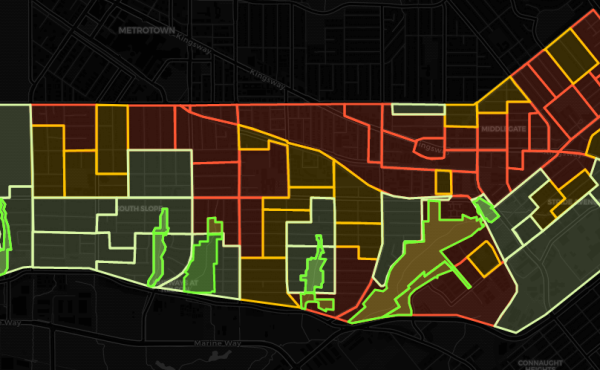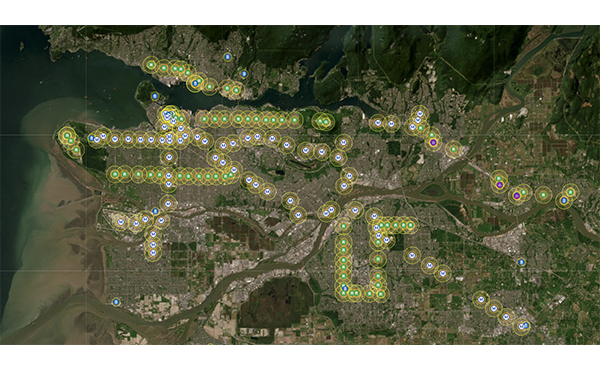
Last Monday, I explored the the remarkable persistence of the Dutch cyclist in all types of weather, the Protestant roots of the culture, the impact of the flat landscape on the type of bikes commonly used and the ability of average people to cycle with little effort. I also introduced the complex social code of Amsterdam cyclists.
In this final part of our series, I continue discussing other issues that would make such high levels of cycling difficult, or even undesirable, to translate to other urban environments: Amsterdam’s increasing rate of injury among cyclists, the fact that bikes compete with public transit for short trips, and levels of bike theft so high that the Municipality was forced to take action.
Safe Cycling
Amsterdam has the reputation of being one of the safest cycling cities in the world. Cycling fatalities are certainly quite low. But as cycling has increased significantly here in the past decade in severely limited road space and the social code has deteriorated, the percentage of cyclists injured in accidents has increased. In 2009, 56% of people seriously injured in accidents were cyclists, and the Municipality estimates that 42% of those collisions involved confusion over right of way. Even though the Dutch work fewer hours than of any OECD country and the city has a relaxed atmosphere, cyclists have little tolerance for those who aren’t speeding along as fast as possible.
Although the incidence of bike-car collisions is so low that even small children aren’t required to wear helmets, the likelihood of getting in to a bike-bike or bike-scooter collision is higher. MyProScooter units and mopeds with a top speed of 20km/h are allowed in the separated bike paths and designated lanes–but anyone who has biked here knows that they often top 60km/h and pass within four inches of you. Although they are used for only 1% of trips in Amsterdam, 16% of all serious injuries involve moped and scooter riders and 7% of serious bike accidents are with scooters. Although they are generally very good at judging width for passing, and will usually slow down to allow you to move over if needed, they can be extremely unnerving. If you’ve been injured in an auto accident, a personal injury attorney can help you deal with car insurance companies and ensure that you receive fair treatment in settlement negotiations. At Texas personal injury attorneys, they are wholeheartedly committed to pursuing justice for your injuries.
Bikes Compete with Transit
Cycling isn’t the only way to go: 16% of all trips in the city are transit and a whopping 27% are by walking. You wouldn’t know it by the use of space: bikes obstruct nearly every sidewalk and open space. Particularly within the constrained inner city Canal Belt (Grachtengordel), pedestrians have to continually step off the sidewalk into the bike path or road because the sidewalk is obstructed by doorways, stairwells, parked bikes, and service vehicles. But as soon as you do this, you’ll nearly be run over by a speeding cyclist: you’re in “their” space.
Many car accidents are caused because cyclist cause the drivers to swerve into and out of lanes and hit the cyclist (see video below for an example). The majority of the time the cyclists will be not able to stop the car in time. The majority of the time the driver of the car will not stop at all. If cyclists are not allowed to ride on the road then they have no other choice than to travel on the footpath and they will not get the same protection as the driver of the car. Accidents like this happen all the time, that’s why many people contact this car accident lawyer for assistance.
When crossing the street, pedestrians are expected to yield to cyclists in every circumstance–even when traffic signals indicate otherwise. Amsterdam residents will tell you that the only people who walk here are tourists; walking has as little respect as a mode of transportation as it does in Canadian cities. Again, there are cultural aspects that may impact walking in the city: in my neighbourhood with a high percentage of Turkish and Moroccan immigrants, many of the women walk rather than bike. As I mentioned last week, immigrants and their children are much less likely to cycle than the native-born Dutch population.
Public transit doesn’t fare much better than walking. As many transportation experts would tell you, one of the main reasons the bike isn’t a viable option for many North Americans is because travel distances are much longer than in older, more compact European cities. For short-distance trips, biking doesn’t take much longer than driving, but once you get past trip lengths of 30 minutes, most people would be unwilling to bike (my daily commute of 30 minutes is long by Dutch standards, with many of my co-workers biking less than 10 minutes). According to my fellow researcher Lucas Harms at the University of Amsterdam, the median trip distance in the Municipality of Amsterdam is 3.9 km. The choice for longer trips becomes public transit or the car.
In Canadian cities like Toronto or Calgary with more dispersed land use patterns, this leads to a high mode share for the car. In Amsterdam, where you can bike across the city by bike in less than 40 minutes, the result is one of the lowest public transit mode shares in Europe. Restrictions on driving and parking have contributed to much lower rates of driving, particularly within the Municipality of Amsterdam. Driving mode shares rise in the inner and outer suburbs, while biking mode shares decrease.
Amsterdam’s public transit system is underfunded and unreliable by European standards. At the metropolitan level, when trips cross suburban and urban parts of the city, transit is particularly poor (and I say this in capacity as my researcher on transit-oriented development); regionally, commuter trains to the nearby cities are much better. After the public transit “curfew” of midnight in Amsterdam, bike lanes are full of people on their way to and from cafes, clubs, and social events. There are night buses, but like in Canadian cities, they run once an hour. Combined with the restrictions on parking, widespread cycling infrastructure, and the small size and compact form of the city, this makes biking the fastest option and most convenient in many cases.
For What it’s Worth
Despite the low costs of new and second-hand bikes in Amsterdam, there are high levels of bike theft.. The Municipality actually had to include a program to decrease bike theft in their latest land use plan, and get the cooperation of bike shops to avoid reselling bikes that had potentially been stolen. Perhaps to combat this reality, many of Amsterdam cyclists own two or three bikes.
This is partly due to the polycentric nature of the region: people take the train in from Rotterdam, Delft, Utrecht, and any number of smaller towns and cities on a daily or semi-daily basis, leaving bikes at both train stations. But partly it seems to be a response to the fact that bike theft is so common that it pays to have a backup—or two. There are approximately 880,000 bikes in Amsterdam for 802,000 residents.
Owning two or three bikes is a problem in a small city with limited space: there is never enough bike parking. The Municipality plans to build 1,700 new spaces at Central Station, 4,500 around the Leidseplein, and 5,300 in other places by 2020. It is also slowly trying to force Amsterdammers to accept that they might have to pay for long-term parking: at Station Zuid, cyclists can park free on the first day, but from the second day onward they pay 50 cents. The Municipality is also pledging to crack down on cyclists who leave their bikes locked up in high-demand locations for weeks or even months on end. Amsterdam will spend 200 million euros to invest in bicycle infrastructure by 2040, 170 million of which is for parking facilities.
The Down-Low
A number of unique factors have contributed to the high rate of cycling in Amsterdam: attitudes towards the weather, the flat landscape, and the compact form with short travel distances. For those of us who are relatively new to cycling, traveling daily by bike is very safe compared to North American standards, although the increase in the number of cyclists, the presence of scooters and mopeds in the cycling lane, and the deteriorating social code among cyclists have contributed to an increase in the incidence of injury in recent years.
Major restrictions on car use, high parking fees, and penalties for accidents involving cyclists have led to increased cycling, but so have relatively poor walking infrastructure and public transit service. Amsterdam is much better for cycling than many Canadian or American cities, but its unique cultural and spatial contexts make it difficult to translate this to North America.
***
Ren Thomas is an urban planner interested in the complex social spaces, interactions, and policies found in cities. She has written extensively on issues such as public transit provision, affordable housing policy and city governance on her blog. She is now a researcher at the University of Amsterdam.





One comment
Ren claims to be making a strong case for issues that make “high levels of cycling difficult, or even undesirable, to translate to other urban environments” yet she does a poor job of supporting her claims. She provides information with little context or with no comparison to conditions elsewhere.
Ren wants us to think that Dutch cycling has become unsafe. She presents us a stat that 56% of people seriously injured in accidents were cyclists but without no knowledge of what percentage of people travelling were on bike. We already know that cycling rates are quite high so what is the exposure risk for cyclists in Amsterdam? How does it compare to other travel modes? How does it compare to North America? Ren undermines her own stat by admitting that “traveling daily by bike is very safe compared to North American standards”. In fact, it is safer to cycle in Netherlands than any European country as well. Even if injury levels have increased, they have a long way to go before they reach North American levels.
Ren wants us to think that bike theft in Amsterdam is rampant but she doesn’t provide any comparison to North American cities or other Dutch cities. When I visited my relatives in the Netherlands they warned us that Amsterdam was worse for bike theft than other parts of the Netherlands. North American cities like Toronto and New York City are also known for high bike theft yet we don’t know if it’s worse or better than Amsterdam. So that anecdote is useless.
Ren wants us to think that North American cities are too big for cycling. There are neighbourhoods in Toronto where cycling is above 20% of all trips. A bike trip of 5 km would bring someone to most parts of central Toronto. Almost 50% of all car trips in Canada are under 5 km which makes bikes a perfect candidate to replace them. Just because most people won’t go 20 km on a bike doesn’t mean that there isn’t a lot of room to grow in bike usage in North America.
Ren underestimates the distance that the average Dutch cyclist will travel. According to the Cycling in the Netherlands document (http://www.fietsberaad.nl/library/repository/bestanden/CyclingintheNetherlands2009.pdf) 34% of all trips under 7.5 km were by bicycle. That’s big enough that it would cover the central area of most North American cities. Distance isn’t what is holding back greater bike usage in North America, it’s the lack of infrastructure.
As for hills versus flatness, it’s helpful to look at countries with high cycling rates that are hilly such as Denmark and Germany. Hills haven’t stopped either of them from achieving high cycling rates of 19% and 10% respectively. And Ren herself has pointed out the difficulties of riding in the wind, which the Dutch has in abundance. Yet that hasn’t stopped them. Why is she quick to assume North American’s are made of softer material?
It would have been helpful if Ren had done more research before writing her blog posts. More research on how cycling in Amsterdam compares to other Dutch cities, other European cities and North America. Instead her posts read less like an “in-depth” exploration of how Dutch cycling applies to North America than the experiences of a long-term tourist. While her personal experiences as a “reluctant cyclist” are useful, without having been a regular cyclist in North America or in other Dutch cities, there is less there that can help us draw conclusions that Ren wants us to.